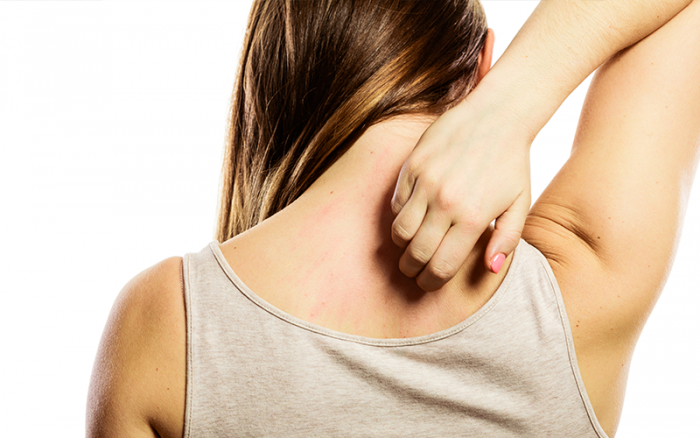The term “rash” is generically used to describe a wide range of skin issues. While many rashes are mild and will go away on their own, others could be a symptom of a more serious skin condition.
If you have a rash, when should you contact a dermatologist? Here are five of the most common types of rashes that typically require medical treatment:
#1: Eczema
If you have an itchy rash that won’t go away on its own, it could be atopic dermatitis, also known as eczema. This very common skin condition affects some 31 million Americans and is characterized by inflammation of the skin that ranges from mild redness and itching to cracked, crusty skin and weeping blisters.
Eczema can appear as patches on the hands, feet, neck, upper body and limbs and is often triggered by allergens, medications, heat, infections and some immune system disorders.
For some, eczema flares up sporadically and causes severe symptoms. For others, it is a chronic condition with milder symptoms. Though there is no cure, there are many treatments that can lessen the symptoms of eczema. Treatments include high-quality moisturizers, prescription-strength ointments and creams and other topical and oral medications.
#2: Psoriasis
Psoriasis is a chronic autoimmune condition that develops when the immune system mistakes skin cells for a virus or other infection, causing skin cells to grow too quickly. Psoriasis usually appears as raised patches of skin that become red and inflamed. These areas can sometimes be covered with a silvery-white, scaly, itchy coating.
Psoriasis most frequently occurs on the elbows, knees, scalp and lower back, but patches can appear anywhere. It can be triggered by stress, extreme weather, illness, changes in hormones, sunburn and even some medications. Treatment generally begins with a topical cream to reduce inflammation and can also include oral and injectable medications. Phototherapy (light therapy) can also be used to treat psoriasis by slowing the growth of skin cells.
“Typically, psoriasis goes through cycles of improving and worsening over time,” says Dr. Russell Peckham of U.S. Dermatology Partners Cedar Park. “There is no known cure, but there are many available treatments to reduce symptoms depending on the severity of your condition.”
#3: Shingles
Shingles (herpes zoster) is a painful, blistering rash caused by the chickenpox virus. Anyone who has ever had chickenpox already has the virus that causes shingles in their nerve tissue. The dormant virus can reactivate — even many years later — and cause shingles.
Typically, shingles begin as mild itchiness or pain that develops into a cluster of small blisters in a defined area on one side of your body. Over the course of a few days, the blisters break and leave behind painful ulcers. These ulcers eventually dry out and crust over. They typically heal completely in around four weeks.
If taken early enough, oral antiviral medications can help reduce the length of infection and the symptoms and pain associated with shingles. A shingles vaccine is also available to patients over the age of 60.
#4: Rosacea
Rosacea is a chronic skin condition that affects millions of people. It causes redness or flushing of the face, sometimes accompanied by small bumps. The exact causes of rosacea are unknown, but genetics are thought to play a role. Individuals with fair skin are at higher risk of developing rosacea.
Rosacea occasionally flares up as a result of stress, hot and spicy foods, extreme temperatures, skin products, alcohol consumption or sun exposure. Though there is no cure, there are many treatments to reduce the symptoms of rosacea.
“Medication can be prescribed to reduce the redness associated with rosacea and some lifestyle changes can also often lessen your symptoms,” says Dr. Peckham.
#5: Contact Dermatitis
Contact dermatitis is another form of eczema that occurs when the skin comes in contact with an irritant such as an industrial chemical or harsh cleaning product. This condition causes a dry, scaly rash that does not typically itch.
Allergic contact dermatitis is caused by allergens such as latex rubber, poison ivy, and even nickel. It appears as a red rash with bumps and blisters. Your dermatologist can prescribe medicated creams and topical ointments to reduce your symptoms.
Looking to Visit a Dermatologist?
Though many rashes are harmless and will go away on their own, some share symptoms with more serious skin conditions. If you have a persistent, uncomfortable rash, it is important to have a dermatologist take a look to confirm your diagnosis and recommend the best treatment plan. Be careful not to scratch your rash, which can lead to breaks in the skin and serious infection.
Do you have a rash or other skin condition that should be examined by a professional? Contact U.S. Dermatology Partners today to make an appointment with one of our board-certified dermatologists. We have multiple locations throughout the country, so fill out our simple online form to get in touch with us. One of our local team members will reach out to you shortly to answer your questions or schedule an appointment for you to visit us soon.
Find a location near me
or

